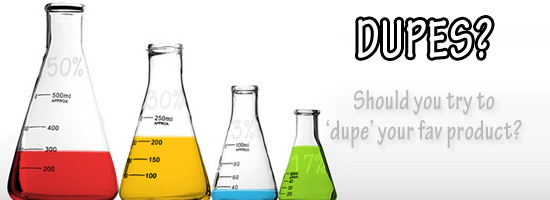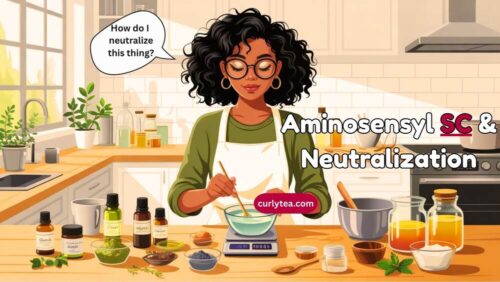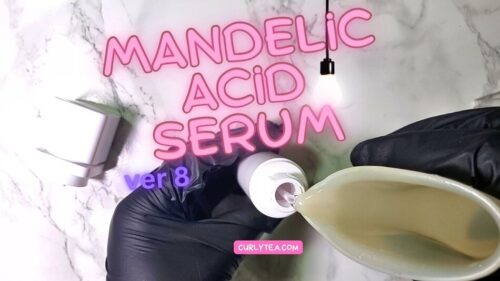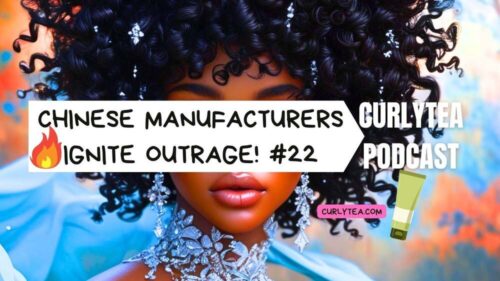Dupe: Is there A Good Way To Figure Out the Percentages of your Fav Product?

Recently, an email question came in asking about the creation of a diy mix similar to a popular product.
I learned a long time ago not to fool with trying to make a real dupe of a product already on the market. It can be a headache and a total waste of ingredients.
Walking down the road of trying to match what's already on the market may hinder creative skills. You may be able to create something which works even better for your own hair if you're not so focused on copying a product.

Product Dupes: Is there A Good Way To Dupe Your Favorite Product? Recently, an email question came in asking about the creation of a diy mix similar to a popular product.
I learned a long time ago not to fool with trying to make a real dupe of a product already on the market. It can be a headache and a total waste of ingredients.
Walking down the road of creating product dupes may hinder creative skills. You may be able to create something which works even better for your own hair if you’re not so focused on copying a product.
However, if you want to use similar ingredients or follow the general pattern of percentages used in your favorite product, that’s possible.
Manufacturers aren’t going to tell you their secret sauce so that you can dupe it! That would be stupid as h***. LOL! You’ll most likely have to guess at what percentages of ingredients were used. Many times, though, there are telltale signs to give you an indication of where to start guessing.
Normally, companies will use additives which have a maximum recommended usage rate set by the manufacturer of that particular ingredient. Those usage rates are in percentages.
If you look up that specific ingredient online, you can find the maximum suggested usage rate percentage. For example, the maximum suggested usage rate for powdered DL-Panthenol (ProVitamin B5) is 2%. That means the manufacturer/wholesaler recommends people use no more than 2% of it in their product.
Since you know the maximum usage rate is 2% for DL-Panthenol, every other ingredient listed after Panthenol on the product’s ingredient list is probably used at either 2% or less.
However, you’ve now hit two brick walls:
(1) If the company simply lists “Panthenol” in their ingredient list, you don’t know which version of panthenol they’ve used. Panthenol comes in a powdered form and a liquid form. The usage rate for the liquid form of DL-Panthenol is 2%-10%. The usage rate for the powdered form of Panthenol is 1%-2%. So, which one did they use?? You don’t know.
(2) The assumption is the company has used the manufacturer’s maximum recommended amount. So, what if they didn’t use the recommended amount? What if they only used 1% DL-Panthenol? Or what if the company completely ignored the recommendation and used 3% or 4% powdered Panthenol instead? Or 11% liquid panthenol? So which is it?? You don’t know.
Let’s see how frustrating it can get attempting to dupe a product at home. Pretend this is the ingredient list for a great, natural hair product that you want to dupe:
Water, Aloe Vera gel, Shea butter, Cocoa butter, BTMS, Avocado oil, Cetyl alcohol, Neem oil, vitamin E, Optiphen, Fragrance, Rosemary essential oil
What are the telltale signs from this recipe list for you to begin a dupe? Focus on the additives, emulsifiers, thickeners and extracts in the ingredient list.
The first one that sticks out is BTMS. However, unless the full INCI of BTMS is listed on the product, you don’t know if they’ve used BTMS-25 or BTMS-50.
Both BTMS-25 and BTMS-50 have a recommended usage rate of 1-10%. However BTMS-50 — I can now say from personal experience — is RIDICULOUSLY more conditioning than BTMS-25. I’m not even exaggerating. But I digress.
At the very least, you can guess that BTMS makes up no more than 10% of the product based on the sample ingredient list above. But how can you be sure? You really can’t.
How do you know if the company has used BTMS at 7% or 3%? There’s a big difference in the way 7% BTMS-50 feels in your hair versus 3% BTMS-25. You’ll just have to guess, write your recipes and test out the different percentages for yourself. (I’ve read that some DIYers think using BTMS at anything over 6% would be overkill in a hair conditioner)
Another way to dissect it is to go by the first two ingredients in our sample ingredient list: Water and Aloe Vera gel.
The ratio between the two can be almost anything. Maybe they used 30% water and 30% Aloe Vera gel? OR maybe they used 78.5% water and 3% Aloe Vera gel? At the very least we know there is either more or the exact same percentage of Water in the product as Aloe Vera gel.
However, upon using those two guesstimates, you may end up with two COMPLETELY different mixes.
Let’s start with the first 30% Water/30% Aloe Vera guess, then simply continue to guess at what the other percentages of ingredients are. Remember, our guiding light is that BTMS is used at no more than 10%. If they used BTMS-50:
30% Water
30% Aloe Vera Gel
10% Shea butter
10% Cocoa butter
6% BTMS-50
5% Avocado oil
3% Cetyl alcohol
2% Neem oil
2% vitamin E
1% optiphen
1% Rosemary Essential oil
# The above mix will be thicker and more conditioning because of the higher percentage AND use of BTMS-50. It will be thicker just given the fact it’s made up of 20% butters. It also has a high percentage of Aloe Vera, which would possibly ensure the pH is about 4.5 or 5. But be on the lookout for any possible separation.
Compare that recipe to the 78.5% Water/ 3% Aloe Vera guess we made earlier. The following recipe uses the exact same ingredients in the exact same order of importance, only at different percentages. Remember, BTMS is the guiding light at no more than 10%. But what if they used BTMS-25 instead? The recipe could look like this:
78.5% Water
3% Aloe Vera Gel
3% shea butter
3% Cocoa butter
3% BTMS-25
3% Avocado oil
3% Cetyl alcohol
1% Neem oil
1% vitamin E
1% optiphen
0.5% Rosemary Essential oil
# The above mix will most likely be thinner and will be less conditioning. It has a lower percentage of shea and cocoa butters, so it is apt to have a much less substantial feel on the hair in comparison to the first recipe. And you may get some separation… (especially if you decided on a whim to skip the Cetyl alcohol altogether. Been there. Done that. LOL!)
Moral of the story is if you try to make a real dupe of a product, there’s a chance of creating something much better for yourself… OR something much worse than what you were expecting. It can be a total crapshoot unless you’re a lucky guesser! LOL!
Of course as I stated earlier, this entire method is extremely imperfect because it depends heavily on the company abiding by the manufacturer’s recommended usage rates for the ingredients they’ve chosen to use. It also depends greatly on your guesses being more accurate than not.
This is why trying to create a real dupe at home can be a total waste of time without constant and methodical testing.
With all that aggravation, I really don’t worry about duping a product. Unless that company has used a pre-made base for their product, it may be difficult to make an exact match.
At this point in my own DIY journey, I recommend focusing more on building your own recipes around an ingredient or group of ingredients to which you think your hair will respond well.
If you know shea butter and aloe vera juice make your hair moisturized for days, start off using those two. If you want to add strength and you do well with Panthenol-containing products, throw panthenol in your recipe too. If you’re looking for natural shine/sheen, focus on tea-based extracts or use tea as a base for your mix.
Put all those things together and you’ll be well on your way to a great DIY mix!
Happy DIYing!



